Itinerary to Etna feet 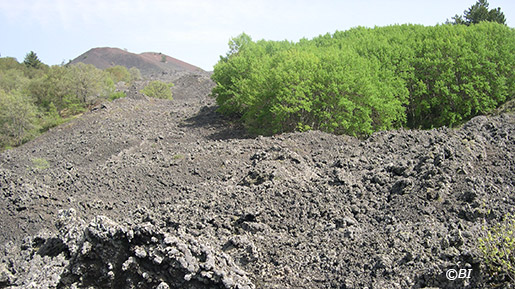 As Giuseppe Cimbali wrote, only at Bronte Etna "shows itself in all the agreement, in all the purity, in all the harmony of his perfect and solemn lines". As Giuseppe Cimbali wrote, only at Bronte Etna "shows itself in all the agreement, in all the purity, in all the harmony of his perfect and solemn lines".
The Bronte's territory which stands in the Park Of Etna (about 10.000 hectares) is rich of naturalistic wonders that the following route shall try to show to you.
There is a mixed way to do it, in part driving and in part on foot. For the part falling down inside the parks, it is advisable to contact a guide; if required, it is possible to get in touch with the C.A.I. (Club Alpino Italiano) of Bronte. Driving on the road that takes to the SS Christ quarter it is possible to enjoy, after few kilometers, the sight of Etna and a true immense plain of lava. At the end of the asphalted road, before leaving the characteristic road paved with lava squared slabs, park the car and go on foot. Going up the road, inside a wide area of the lava of 1651-53, are found the "lave cordate" (lava ropes) remarkably rich in the variety of patterns.
Further on, in the vicinity of the "Dagala Inchiusa" is possible to see the emerging of sedimentary rocks, among the most ancient of the "basement of Etna". The place is also rich in numerous "pagghjari 'n petra" (stone shelters), the characteristic ancient shelters of the shepherds and charcoal burners of Etna built with a circular plan and domed roof only with local stones without the use of any mortar. You can continue to drive along the characteristic road paved with roughly squared slabs made of lava stone as far as the "Piano dei Grilli" (crickets' flat); the road is obstructed at this point by the gate of the Foresters. Having parked the car, it is possible now to continue on foot (or on a bicycle). After crossing the gate, a nature path starts inside the zone "A" of the Etna park. | 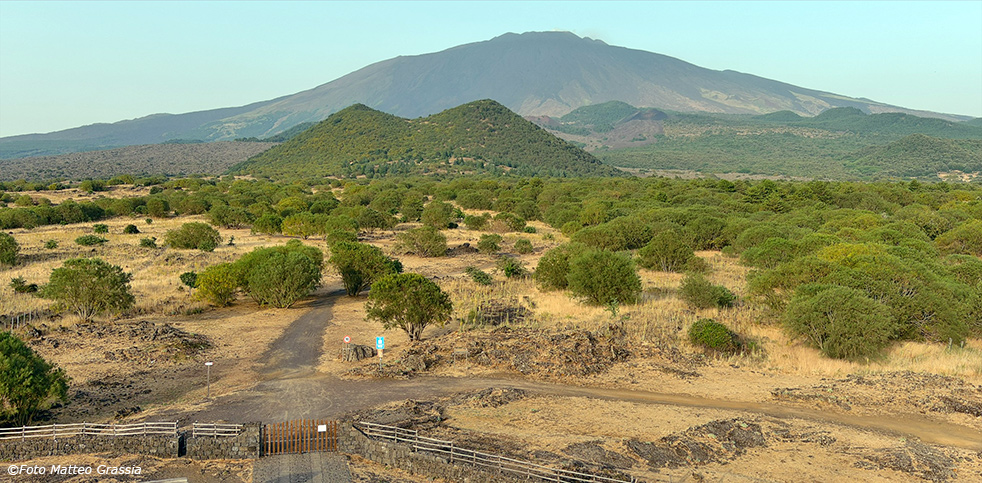 Bottom left, the Forestry gate that limits car access to the Park at Piano dei Grilli. In the foreground, Monte Ruvolo. | | | 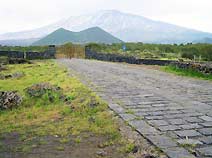 |  |  | 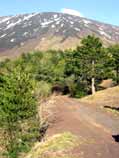 | 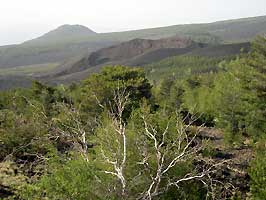 |  | Piano dei Grilli. Here ends the lava paved road, passable by car. In the background Monte Ruvolo and Etna | Snow Cave or College Cave (the vault is partially collapsed) | A river of lava between Monte Arso (1515 m.) and Monte Lepre (1559) has destroyed a flourishing forest | High mountain track (crosses Etna from Monte Vetore to Piano Provenzana) | Monte Nunziata (1803 m.) and in the background Monte Maletto (1740). From Monte Nunziata began the terrifying eruption of November 17, 1843 | A centuries-old oak tree amidst the lava of Etna |
|
|
Along the way you come across:
  "Piano delle Ginestre" (Brooms' plain): singular plain, at 1200 meters of height, called so as impressive brooms plants spread nearly everywhere on the volcano up to the maximum height of 1900 meters, they occupy a wide area of the plain. "Piano delle Ginestre" (Brooms' plain): singular plain, at 1200 meters of height, called so as impressive brooms plants spread nearly everywhere on the volcano up to the maximum height of 1900 meters, they occupy a wide area of the plain.
The Broom Etnea, one of the most typical elements of the Etna landscape, a tree-like plant, is an excellent colonizer of the lava. By virtue of its strong roots it is able to slowly break down the rock, preparing the soil for plants that will settle in later.
In the area there is also the presence of particularly valuable forest ecosystems with rare or completely non-existent species in the remaining part of the Etna territory.
 "Monte Ruvolo" (Ruvolo mountain): (1.410 meters), it is a little cone with two tops with mixed vegetation especially Brooms and big Oak trees. "Monte Ruvolo" (Ruvolo mountain): (1.410 meters), it is a little cone with two tops with mixed vegetation especially Brooms and big Oak trees.
To North of the small cone, near the "Mandre vecchie" (old mandras) is visible a little wooded area, singular biological presence between the lava of 1607.
 "Monte Arso" (Burned mountain): it is a cone, at 1515 meters of height, shaped as a horse shoe, considered of historical epoch, with presence of biological emergencies. "Monte Arso" (Burned mountain): it is a cone, at 1515 meters of height, shaped as a horse shoe, considered of historical epoch, with presence of biological emergencies.
 "Monte Nunziata" (Nunziata mountain), to a height of about 1800 meters, where in the vicinity there is the Grotto of Nunziata Mountain . "Monte Nunziata" (Nunziata mountain), to a height of about 1800 meters, where in the vicinity there is the Grotto of Nunziata Mountain .
 "Monte De Fiore" (De Fiore mountain): it is a volcanic cone , at 1731 meters of height, formed in 1974 during an eruptive activity which gave origin to a singular "gashed dome". "Monte De Fiore" (De Fiore mountain): it is a volcanic cone , at 1731 meters of height, formed in 1974 during an eruptive activity which gave origin to a singular "gashed dome".
| Near the cone, between the lava of 1974, wooded eco-systems were formed with mixed varieties of Pine, Poplar and others.  "Grotta Della Neve" (Grotto of the snow), at around 1160 m altitude near Piano dei Grilli (Crickets' Flat). "Grotta Della Neve" (Grotto of the snow), at around 1160 m altitude near Piano dei Grilli (Crickets' Flat).
Characteristic for the arched vault (partially collapsed) built in lava stone to protect for a long time the snow that accumulated inside every winter for the summer consumption of the boarders of the Royal Capizzi College.
 In the zone can be observed some fauna species of value: the Kestrel, the Porcupine, the Hoopoe, the Partridge, the hares and the foxes. In the area included between "Monte Revolt", "Monte Leper" and "Monte de Fiore" lives the Royal Eagle re-introduced in the territory by the Park authority some years back. In the zone can be observed some fauna species of value: the Kestrel, the Porcupine, the Hoopoe, the Partridge, the hares and the foxes. In the area included between "Monte Revolt", "Monte Leper" and "Monte de Fiore" lives the Royal Eagle re-introduced in the territory by the Park authority some years back.
It is the ornithological presence more spectacular and significant under the ecological aspect. It nests, unique case in the south of Italy, on Larch Pine. |
|
|
|